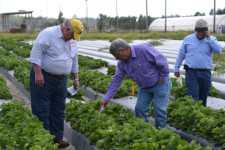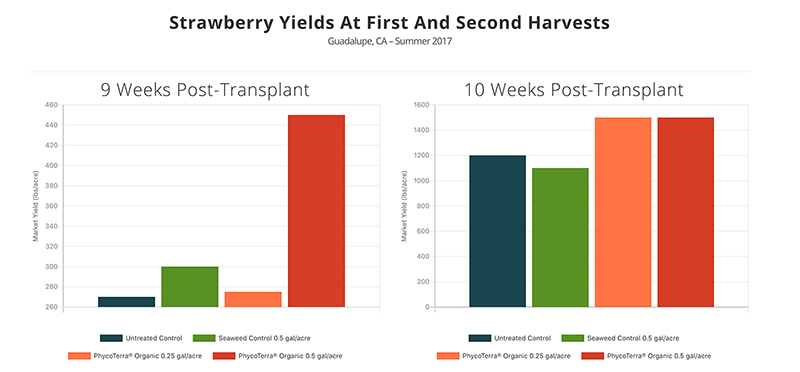Florida Strawberry Growers Look To Stand Out

In February, the Gulf Coast Research and Education Center hosted its annual strawberry field day, which drew a crowd of around 200 people. In addition to field trials showing the latest research in new varieties, insect and disease management, and freeze protection, a grower panel on marketing was featured. Participating were Gary Wishnatzki, Wish Farms; David Spivey, Spivey Farms; and Mark Greeff, Driscoll’s.
Not surprisingly, one universal among the growers on the panel was that quality and food safety has to be mission one. Moderator Ted Campbell, executive director of the Florida Strawberry Growers Association, discussed with the growers how they strive to make their product stand out in a competitive marketplace.
Real Red And Local
Spivey represented the small grower perspective on the panel. He, his father, and brother run a 45-acre operation in Plant City. “My dad built the farm as a local farm, and locally, people want red strawberries — real red,” said Spivey. “They don’t want something that has shoulders, so we carry that over into packing and that is what we are going to pack. Yes, we are aware of the issues that come with packing really red strawberries. We had a lot of trial and error for a few years, with lot more error in the first couple years.
“People at first see them and say, ‘Oh that is overripe.’ So I have to be real selective on my market. I don’t have any chains bigger than 10 stores, but I would say 99% of the year we are sold out. We’ve built up customers a pallet here and a pallet there and they understand our strawberries are blood red.”
Campbell noted that Spivey has done a good job of connecting its brand to Florida’s strawberry identity. On Spivey Farms’ packaging, the official mascot of Florida strawberries “Jammer” is featured, along with the Fresh From Florida logo.
Wishnatzki said his company had recently re-branded its product line. In doing so, he conducted considerable consumer surveys to help with better positioning. In the survey, hardly any consumers could name a brand unaided, other than Plant City, which is not a brand. “We took that survey finding as significant, so when we redesigned our packaging, we made Plant City more prominent on the label,” says Wishnatzki. “We are trying to identify ourselves as East Coast and local.”
Consumer Contact
Reaching out to consumers has become more important than ever. Uses of new technology and social media are enabling the grower to break through the retail level into the consumer’s home. Strawberry growers hope these new approaches will result in the consumer asking the retail buyer to purchase their brand. Greeff noted that Driscoll’s now has more 70,000 likes on its Facebook page. “If you look at our page over the past two weeks (prior to Valentine’s Day), it has all been about desserts and strawberry cocktails for Valentine’s Day. It’s not just the idea of chocolate covered strawberries for Valentine’s. We are driving the potential for new consumption that will drive the retailers to have more strawberries in stock and perhaps even challenge the price point as well.”
2012 Florida Strawberry Field Day Coverage ctd.
Wishnatzki utilizes a traceability technology that his company created called VirtualOne. It allows the consumer to trace back a strawberry to the field and picker level and allows the consumer to go online and provide feedback — good or bad. “We all like to hear positive stuff; you know none of us have ugly children,” joked Wishnatzki. “We don’t solicit feedback enough to tell us what consumers really think. I look at negative feedback as an opportunity. When you get negative feedback, it is a way to say you’re sorry and make it right with your consumer. Hearing the negative, we are able to head the problem off, which is much better than having that person going around telling all her friends not to buy that brand again.”
Food Safety First
With a produce safety rule and Food Safety Modernization Act looming, all the growers agreed that food safety tracking and regulations will grow in importance in the coming year. Although, the growers already place a very high priority on food safety practices.
“You don’t have to look far to see that food safety is important,” said Wishnatzki. “You can see the cantaloupe outbreak and other food safety scares, it really devastated an industry. For that reason alone, it is very important to focus on food safety. You could have one small farmer that has an issue and it will impact all of us here. Traceability is important to trace it back to the picker or item level. You can identify the source of the problem. The Produce Traceability Initiative (PTI) only deals with the case level now, which is important, but I think the item level is where you can see the most benefits.”
Campbell cautioned the crowd of strawberry growers, many of which grow cantaloupes, that federal authorities will be “jumping” on cantaloupes this year after the devastating listeria outbreak. He said to expect FDA inspectors in the packinghouses and the fields.
Making Sense Of Sustainability
The panel concluded with a discussion on sustainability and all agreed that the term is hard to define because it includes so many facets. Greeff said Driscoll’s measures itself in three areas. “Sustainability is driven by three factors: economics; the social side, which includes the community; and the environmental side,” he said. “There are other parts of the world ahead us in terms of measuring their business on all three factors, not just the financial side.”
Spivey pointed out that prices to the farmer can’t be dismissed, especially when the prices of every input in production are on the rise. He noted Mexico is playing a much bigger role in the market and buyers will go there for cheaper berries. But, he added that he believes consumers ultimately want to buy American-grown produce, and that is a message the industry has to continue to push collectively.
“Price is something you get hammered on a lot, says Wishnatzki. “But once you establish a brand and get consumers to identify with it, then you get chain stores to recognize it. You still have to be dictated by the market, but you don’t have to be at the lowest common denominator. You can be at the top, not the bottom end of the market.”










